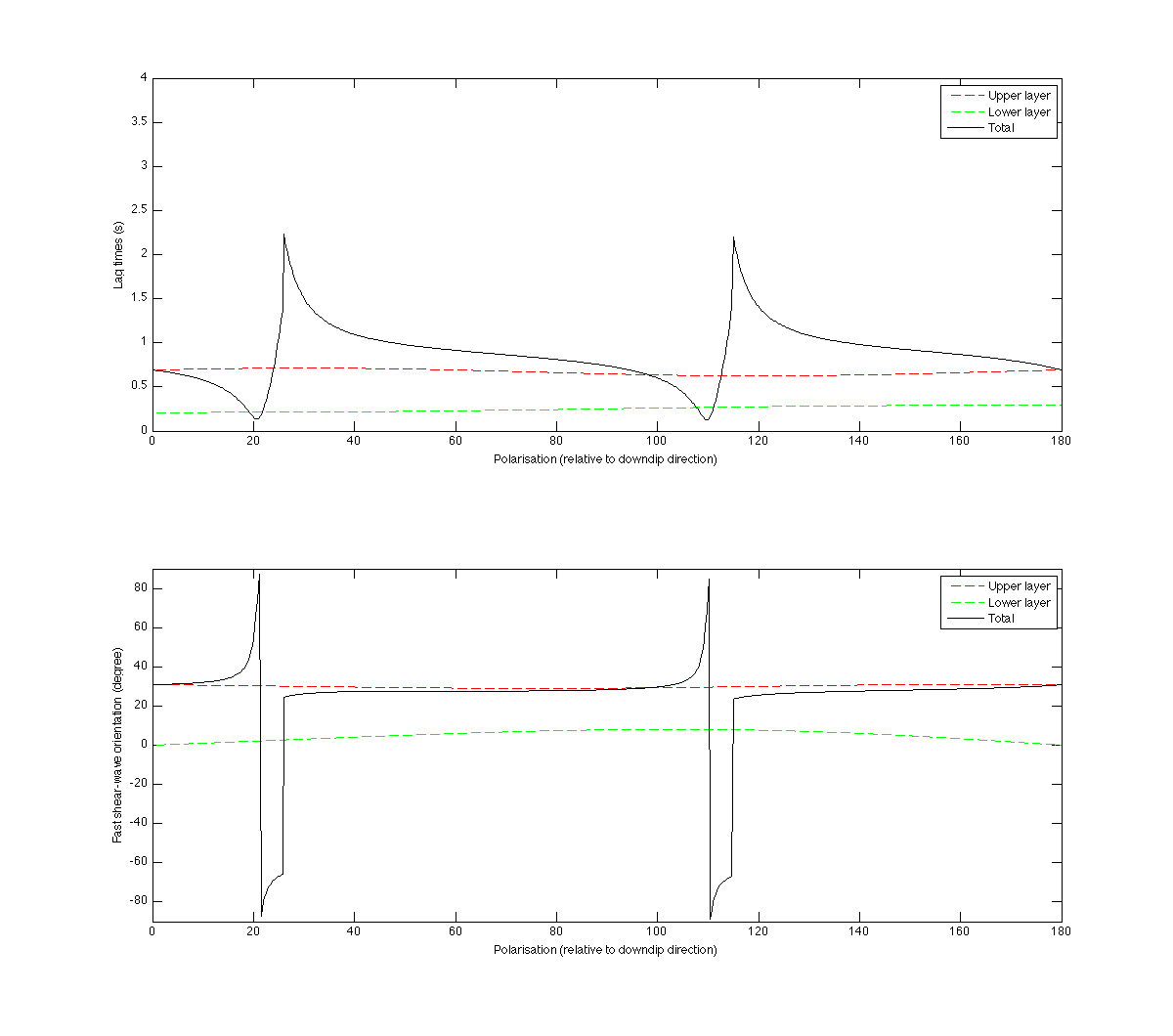This example script demonstrates simple shear-wave splitting modelling using the MSAT toolset. It predicts the SKS splitting variation with backazimuth associated with two dipping, partially-aligned olivine layers. The splitting in each layer is calculated using the Christoffel equation (MS_phasvels), and combined using N-layer effective splitting equations (MS_effective_splitting_N; Silver and Savage, GJI, 1994). Straight raypaths through the upper mantle are assumed.
The source code for this example are contained in the file split_model.m in the examples/splitting directory distributed with MSAT.
The first step is to set up the geometrical parameters of the model and calculate the ray distances in the two layers.
% ** Setup model parameters
S_slow = 4.814 ; % (SKS at 100 degrees from iasp91) ->
aoi = 11.2262 ; % at 100 km depth, angle of incidence
% ** Layer 1 (upper) parameters
L1_depth = 0. ; L1_thick = 100. ; L1_dip = 0.0 ; % layer geometry
L1_aaz = 30.0 ; % a-axis azimuth (rel. to down dip direction)
L1_faln = 0.3 ; % fraction aligned
% ** Layer 2 (lower) parameters
L2_depth = 150. ; L2_thick = 60. ; L2_dip = 30.0 ; % layer geometry
L2_aaz = 0.0 ; % a-axis azimuth (rel. to down dip direction)
L2_faln = 0.3 ; % fraction aligned
report_model(L1_depth, L1_thick, L1_dip, L1_aaz, L1_faln, ...
L2_depth, L2_thick, L2_dip, L2_aaz, L2_faln) ;
% ** imaging parameters
baz = [0:1:360] ; % 0 is down dip direction (perp. to strike)
inc = -ones(size(baz)).*90 + aoi ;
% ** calculate distances
[dist1]=distance_in_dipping_layer(L1_dip,aoi,L1_thick,baz) ;
[dist2]=distance_in_dipping_layer(L2_dip,aoi,L2_thick,baz) ;The example then builds elasticity matrices for the two layers:
% ** load anisotropy, and generate an isotropic version of it.
[Cani,rh] = MS_elasticDB('olivine') ;
[Ciso] = MS_decomp(MS_axes(Cani)) ;
Cani = MS_rot3(Cani,90,0,0) ; % orientation for dry upper mantle
% ** generate layer elasticities:
% This is a Voigt-Reuss-Hill average of the appropriately rotated olivine
% tensor and its isotropic equivalent.
[L1_C,~] = MS_VRH([L1_faln 1-L1_faln],...
MS_rot3(Cani,0,-L1_dip,L1_aaz,'order',[3 2 1]),rh, Ciso, rh) ;
[L2_C,~] = MS_VRH([L2_faln 2-L2_faln],...
MS_rot3(Cani,0,-L2_dip,L2_aaz,'order',[3 2 1]),rh, Ciso, rh) ;Finally, the splitting parameters for each layer are calculated, and then combined:
% ** interrogate elasticities to generate splitting parameters for each layer.
[ pol, ~, vs1, vs2, ~, ~, ~ ] = MS_phasevels( L1_C, rh, inc, baz ) ;
fast1 = MS_unwind_pm_90((baz - pol')) ; % geog. reference frame
tlag1 = dist1./vs2' - dist1./vs1' ;
[ pol, ~, vs1, vs2, ~, ~, ~ ] = MS_phasevels( L2_C, rh, inc, baz ) ;
fast2 = MS_unwind_pm_90((baz - pol')) ; % geog. reference frame
tlag2 = dist2./vs2' - dist2./vs1' ;
% ** calculate the effective splitting between 2 layers
fast_eff = zeros(size(baz)) ;
tlag_eff = fast_eff ;
for i = 1:length(baz)
[fast_eff(i),tlag_eff(i)] = ...
MS_effective_splitting_N(0.125,baz(i), ...
[fast2(i) fast1(i)],[tlag2(i) tlag1(i)]) ;
endResults for this calculation are shown in the graph below. For these parameters the delay time becomes very large when the fast polarisation direction in the upper layer becomes close to parallel or perpendicular to the source polarisation (i.e. around 30 and 120 degrees).

Using optional arguments, the example can be modified to examine if this effect is an artefact of the Silver and Savage method. Adding the arguments "mode" and "GaussianWavelet" changes from the analytical approach to a computation where a wavelet is split by each layer in turn and the resulting splitting parameters measured. Results of this computation ate shown below.

It can be seen that the overall pattern is the same but the very large lag times are reduced.